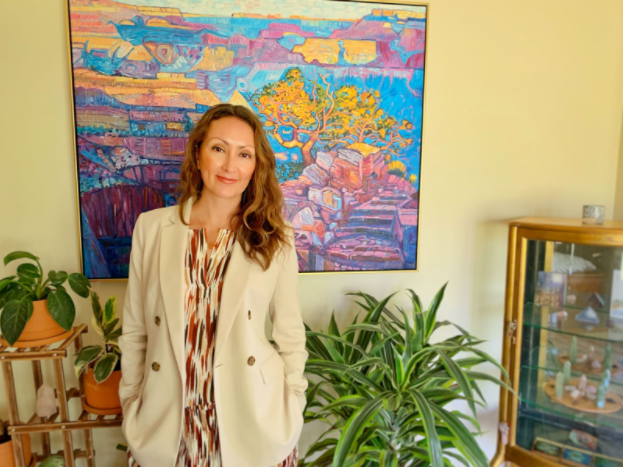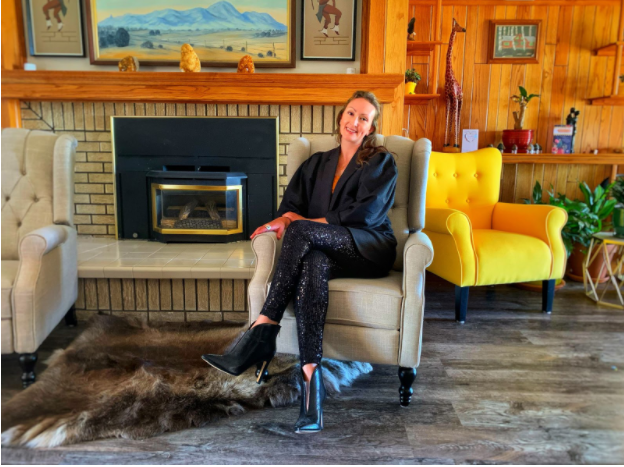Business
Women: How to Find a Publisher For Your Book

Adriana Monique Alvarez has created a new framework for female authors prepared to pioneer their path in book publishing, redefining the traditional publishing model in a revolutionary way that offers a path to financial freedom for thousands of women.
The Wall Street Journal best-selling author and business coach has established a dynamic new publishing style where women deliver their message through books as part of an immersive business model.
“Finding a publisher is much easier than you think. It is right in front of you – look in the mirror,” she says.
Traditional publishing models are obsolete, says Alvarez, dominated by men in an industry that has failed to adapt to changing social environments. “Mainstream publishing houses dump on self-publishing. They called it ‘vanity publishing’ to create a negative impression. Through self-publishing, I have learned how to marry the savvy digital world and business to books that promote practical solutions within the relevant marketplace.”
Her company, AMA Publishing has developed boutique methods that create generational wealth through high-impact, high-earning publishing businesses. With six successful books under her belt, Alvarez has walked the walk. Her methods position books that transform writers into entrepreneurs by springboarding readership to other services and financial freedom.
“Turning a book into a business has worked for men such as Robert Kiyosaki who built a $100 million seminar industry from his Rich Dad, Poor Dad. It’s time for women to tell their stories without waiting for an invitation to succeed.”
Turning dreams into reality for women
Alvarez took her sharp intellect to deconstruct the publishing industry for her business consultancy clients who talked about authoring books of their own. “I had heard these dreams for long enough, and I just said, ‘well, for crying out loud. I guess you’re not going to do it’. So I researched the industry and found niche gaps and open invitations for inspired entrepreneurs to fill.” She knew she had to make the first move. “I started a publishing house for my books and grew it from there. It was a steep learning curve,” she says.
As a world-leading business consultant and veteran of 12 years of building educational modalities, she brought all of her experience to bear when tailoring her boutique publishing curriculum. “My specialty is to take well-organized ideas and promote them through a book,” she says. Her company links books about alternative healing, food, lifestyle, business coaching, therapy, and a range of other professions to the services provided by the author. “A book bestows gravitas on the writer, so I see an expert that is the foundation of a profitable business. Books can lead to podcasts, high-end coaching, and public speaking engagements. My clients are not content to leave the stage to the likes of Tony Robbins.”
Alvarez, who has mentored more than 2500 women, has witnessed her graduates make $100,000 to $500,000 in their publishing companies. Some AMA alumni have netted $75,000 from a book’s launch and then earned monthly revenues from $8,000-$30,000. Traditional book publishing usually projects that most first-time authors will make about $10,000 – in total.
In two years, she has championed 150 women to become best-selling authors. Today her company represents only writers who are ready to achieve bestseller status with The Wall Street Journal. However, she streams new talent to associated successful publishing houses led by her proteges.
Forging a new path
By taking control and running your own book publishing company, Alvarez believes that writers and entrepreneurs can bypass the stumbling blocks thrown up by traditional publishing. “I teach people how to set up and run a publishing business,” she says. “There are so many women who want to tell their story. They just need someone to come along and show them how it’s done; this is what you can do, and here is the next step.”

The way forward is to avoid the well-worn path to an agent and publisher; “After you pitch your book and get rejection after rejection, you will be convinced that you’re not good enough, and you’ll move on with your life. Old school publishing is largely a negative process for new writers, but you have to tell yourself, ‘yes, I am worthy’, and skirt the traditional system, and make your presence known to us.”
Her graduates embrace ambitious millennials who are on track to running a seven-figure business. Others include women making a career jump, and some that want to leave a legacy for their children. From young to old, she teaches them how to get published.
However, getting a book onto the shelves and out through Amazon is just one aspect of creating a business. “Reaching the number one position on Amazon can be taught, but that is not the point of writing a book.” She says that harnessing communities and self-exploration are essential to writing, researching, and editing. “My clients often find answers to philosophical questions including why they are doing what they do, what values they hold, what they stand for and who they are by going through the vigorous process of writing.”
An author also creates a solid community of people interested in what they are doing and their journey. “This community helps the author to grow and to sell their products or services,” she says.
Ordinary people with extraordinary stories
Alvarez believes that her students are ordinary people with extraordinary stories to tell. She has also survived through catastrophe, having endured the stillbirth of her daughter Nina while living in Albania.
“Having success and optimism is one part of the picture that also reaches into grief, pain, and loss. The method that I teach is a deep process and has an emotional impact on women as they explore past experiences that may include trauma, violence, and loss. If I had not swum in deep waters, I don’t think I could teach the course,” she says.
Alvarez released her latest book, How to Create a Six-Figure Publishing Business in June 2021. Then, in July, she will launch The Younger Self Letters – How Successful Leaders Turn Trials into Triumphs. Both books are already bestsellers on Amazon, giving further inspiration to a broad audience of women for whom she holds the key to a new path in publishing success.
Business
Royal York Property Management And Nathan Levinson On Building Stable Rental Portfolios In A Volatile Market

Across North America, Europe, and much of the world, rental housing is caught between two pressures. On one side are tenants facing record affordability challenges. On the other side are landlords seeing operating costs, interest payments, and regulatory complexity move in the opposite direction.
Recent analysis from Canada’s national housing agency shows how tight conditions still are. The average vacancy rate for purpose-built rentals in major Canadian centres rose to about 2.2 percent in 2024, up from 1.5 percent a year earlier, but still below the 10-year average despite the strongest growth in rental supply in more than three decades.
At the same time, higher interest rates have pushed up the cost of acquiring and financing rental buildings, which has slowed transactions and made many projects harder to pencil out.
In this environment, the question for landlords and investors is less about chasing maximum rent and more about building stability. That is where Royal York Property Management and its founder, president, and CEO Nathan Levinson have drawn attention.
From a base in Toronto, Royal York Property Management manages more than 25,000 rental properties, representing over 10 billion dollars in real estate value, and operates across Canada, the United States, and parts of Europe. Levinson also sits on a Bank of Canada policy panel focused on the rental market, where he provides data and on-the-ground insights about rent trends and landlord stress.
For many smaller property owners, his model has become a reference point for how to treat rental housing as a structured financial asset rather than a side project.
Rental housing under pressure from both sides of the balance sheet
In many countries, the basic rental story is the same. Construction of new rental housing has climbed, yet demand still runs ahead of supply in most major cities. In Canada, overall rental supply grew by more than 4 percent in 2024, the strongest increase in over thirty years, while vacancy rose only modestly.
At the same time, borrowing costs have moved sharply higher compared with the pre-pandemic period. Research shows that elevated interest rates have reduced the profitability of new multifamily deals and slowed investment activity, even as structural demand for rental housing stays strong.
For small and mid-sized landlords, that tension shows up in a simple way. Mortgage payments, taxes, insurance, and maintenance rarely move down. Rents move up more slowly, and in many jurisdictions they are constrained by regulation or market realities.
Levinson’s view is that this gap will not close on its own. Landlords who want to stay in the market need more predictable income, tighter control of costs, and clearer systems for dealing with risk.
A property management model built for volatility
Royal York Property Management did not start as an institutional platform. Levinson’s early clients were owners of single condominiums, duplexes, or small buildings who were struggling with irregular rent payments, surprise repairs, and complex rental rules.
Instead of handling each property ad hoc, he built a standardized operating model that treats every door as part of a wider portfolio. Each unit sits on a centralized platform that records rent, arrears, lease expiries, maintenance tickets, and legal actions. Owners see real-time statements and performance metrics rather than waiting for year-end reports.
That structure, combined with an internal maintenance and legal team, is designed to handle stress rather than avoid it. When markets are calm, the system may look conservative. When conditions worsen, it is what keeps owners in the black.
“Execution is everything” is how Levinson often frames it in interviews.
Turning rent into a more predictable income stream
The feature that first drew many investors to Royal York Property Management is its rental guarantee program in Ontario. Under this model, landlords receive their rent even if a tenant stops paying. RYPM takes responsibility for legal proceedings, arrears recovery, and re-leasing the unit, while the owner continues to receive income.
Independent profiles of the company describe this as one of the first large-scale rental guarantee frameworks in the Canadian market, and note that the firm manages tens of thousands of units under this structure.
The guarantee itself is closely tied to local law and does not transfer directly into every jurisdiction. The underlying logic, however, is straightforward:
- Treat unpaid rent as a recurring and manageable risk rather than an occasional shock.
- Price that risk into a clear product instead of handling each case informally.
- Use scale, legal expertise, and data to keep default rates low and resolution times shorter.
For landlords who are facing mortgage renewals at higher interest rates, having a more stable rent stream can be the difference between holding a property and being forced to sell. That is one reason rental guarantee models have started to attract interest from investors outside Canada who are watching RYPM’s approach.
Using technology to see risk earlier
Behind the guarantee and the day-to-day operations is a technology stack that tries to surface problems before they become crises. Royal York Property Management’s internal platform uses data from payments, maintenance, and tenant behavior to flag risk signals and operational bottlenecks.
Examples include:
- Tenants who move from on-time payments to repeated short delays.
- Units where small repair tickets point to a larger capital issue ahead.
- Buildings where complaint volumes suggest service gaps or staffing problems.
Rather than treating these as isolated events, the system aggregates patterns across thousands of units. That allows management to decide whether a problem is individual, building-specific, or systemic.
Levinson has also pushed this data outward. As a member of the Bank of Canada’s rental policy panel, he provides anonymized information on rent collection, defaults, and renewal behavior, which feeds into broader discussions about financial stability and housing policy.
The same data that protects a landlord’s cash flow in one building helps central bankers understand how higher rates are affecting thousands of households.
Why the Canadian case matters for global landlords
Several recent reports underline how closely rental markets are now tied to national economic performance. Tight rental supply and high rents are feeding inflation in many economies. At the same time, higher borrowing costs are discouraging new construction, which risks prolonging shortages.
This feedback loop is especially hard on small landlords. Many own only one or two properties and have limited room to absorb higher mortgage payments or extended vacancies. Analysts in Canada and abroad have warned that some owners are at risk of default as their loans reset at higher rates.
In that context, the Royal York Property Management model offers three lessons that travel across borders:
- Standardization protects both sides. Clear processes for screening, rent collection, maintenance, and legal steps reduce surprises for owners and tenants at the same time.
- Risk pooling is more efficient than one-off crises. Handling arrears, legal disputes, and vacancies inside a structured system is less costly than improvising each time.
- Operational data belongs in policy conversations. When policymakers have access to real rental data rather than only mortgage statistics, interventions can be better targeted.
It is not an accident that Levinson’s work now sits at the intersection of private property management and public financial policy.
What everyday landlords can borrow from the Royal York playbook
Most landlords will not build a 25,000-unit management platform. Many will never interact with a central bank. The core ideas behind Nathan Levinson’s approach are still accessible to smaller owners that manage a handful of properties.
Three practices stand out.
First, treat every rental unit as part of a simple portfolio. That means using a consistent template to track rent, arrears, expenses, and vacancy days for each property, then reviewing it on a schedule instead of only when something goes wrong.
Second, write down the rules for risk in advance. Late-payment steps, repayment plans, documentation standards, and maintenance response times should exist on paper, not only in memory. Royal York’s experience suggests that clear rules reduce conflict, because everyone knows what will happen next.
Third, invest in service as a protective layer. Multiple independent profiles of RYPM point out that faster response times and transparent communication reduce tenant turnover and protect building condition, which in turn supports long-term returns.
For landlords and investors trying to navigate today’s volatile rental markets, the message from Royal York Property Management and Nathan Levinson is surprisingly simple. You cannot control interest rates or national housing policy. You can control how organized your portfolio is, how clearly you manage risk, and how consistent your operations feel to the people who live in your buildings.
For many, that shift from improvisation to structure is what will decide whether their rental properties remain a source of wealth or turn into a source of stress.
-

 Tech5 years ago
Tech5 years agoEffuel Reviews (2021) – Effuel ECO OBD2 Saves Fuel, and Reduce Gas Cost? Effuel Customer Reviews
-

 Tech6 years ago
Tech6 years agoBosch Power Tools India Launches ‘Cordless Matlab Bosch’ Campaign to Demonstrate the Power of Cordless
-

 Lifestyle6 years ago
Lifestyle6 years agoCatholic Cases App brings Church’s Moral Teachings to Androids and iPhones
-

 Lifestyle5 years ago
Lifestyle5 years agoEast Side Hype x Billionaire Boys Club. Hottest New Streetwear Releases in Utah.
-

 Tech7 years ago
Tech7 years agoCloud Buyers & Investors to Profit in the Future
-

 Lifestyle5 years ago
Lifestyle5 years agoThe Midas of Cosmetic Dermatology: Dr. Simon Ourian
-

 Health7 years ago
Health7 years agoCBDistillery Review: Is it a scam?
-

 Entertainment6 years ago
Entertainment6 years agoAvengers Endgame now Available on 123Movies for Download & Streaming for Free
